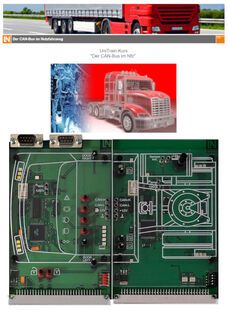Course: CAN bus in commercial vehicles

In commercial vehicles, communication between the various control units as well as sensors and actuators plays a decisive role. In the course of the ever more extensive automotive electronification, not only the requirements grew, but also new fields of application were opened up. In this context, the safety-relevant and multimedia sectors deserve special mention.
In order to meet the requirements, especially in these areas, a large number of different bus systems have been developed. Over time, however, one bus system has made a special name for itself - the Controller Area Network - Bus, or CAN-Bus for short. Exactly this bus system is the content of this course. On the following pages you will get a detailed and comprehensive insight into the theory and practice of this bus.
Includes:
- 2 Experiment cards (front and rear of truck) with emulation of a complete CAN bus system for utility vehicles including actuators, sensors and dashboard
- Two microcontroller systems with communication via the CAN bus
- Cascading via CAN-IN and CAN-OUT on Sub-D9 connectors
- CAN node I with indicators, lights, simulated key, fuel tank indicator, temperature sensors, and more
- CAN node II with rear light, fuel tank simulation, electric window, central locking functions, and more
- Storage case
- Labsoft browser and course software
Course contents:
- List of reasons for increasing use of bus systems in utility vehicles
- Identifying various bus systems in utility vehicles
- Introduction to the topology and components of a CAN bus in a utility vehicles
- Introduction to the difference between low-speed and high-speed CAN buses
- Experimental determination of electrical properties of a CAN bus
- Experimental determination of (low-speed and high-speed CAN buses)
- Introduction to the principles of addressing and arbitration on a CAN bus
- Determining identifiers by measurement
- Introduction to the structure of a message frame for a CAN message
- Analysis of CAN packets using the CAN monitor and an oscilloscope
- Interpretation of CAN packets using the CAN monitor and an oscilloscope
- Editing and transmitting CAN message via PC
- Investigating the effect of termination on a low-speed and high-speed CAN bus by measurement
- Fault simulation (8 simulated faults activated by relay)
- Course duration 7 h approx. (fault finding 1.5 h approx.)